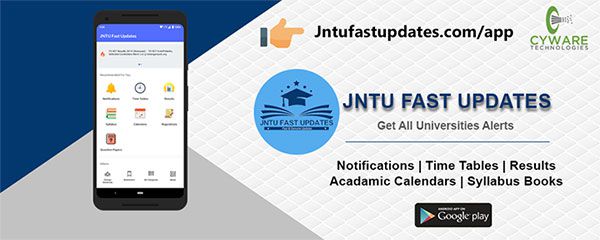JNTUK R19 2-2 Applied Thermodynamics Material/Notes PDF Download
Students those who are studying JNTUK R19 Mechanical Branch, Can Download Unit wise R19 2-2 Applied Thermodynamics Material/Notes PDFs below.

JNTUK R19 2-2 Applied Thermodynamics Material/Notes PDF Download
OBJECTIVES:
- This course is intended to study the thermodynamic analysis of major components of Rankine cycle, refrigeration cycles and compressible fluids and to analyze the energy transfers and transformations in these components including individual performance evaluation.
UNIT-1
VAPOUR POWER CYCLES: Carnot, Rankine cycle – schematic layout, thermodynamic analysis, concept of mean temperature of heat addition, methods to improve cycle performance – regeneration & reheating.
COMBUSTION: Fuels and combustion, concepts of heat of reaction, adiabatic flame temperature, Stoichiometry, flue gas analysis.
Download UNIT-1 Material PDF
UNIT-2
BOILERS : Classification – working principles of L.P & H.P boilers with sketches – mountings and accessories – working principles, boiler horse power, equivalent evaporation, efficiency and heat balance – Draught: classification – height of chimney for given draught and discharge, condition for maximum discharge, efficiency of chimney – artificial draught, induced and forced.
Download UNIT-2 Material PDF
UNIT-3
STEAM NOZZLES: Function of a nozzle – applications – types, flow through nozzles, thermodynamic analysis – assumptions -velocity of fluid at nozzle exit-Ideal and actual expansion in a nozzle, velocity coefficient, condition for maximum discharge, critical pressure ratio, criteria to decide nozzle shape: Super saturated flow – its effects, degree of super saturation and degree of under cooling, Wilson line.
STEAM TURBINES: Classification – impulse turbine; mechanical details – velocity diagram – effect of friction – power developed, axial thrust, blade or diagram efficiency – condition for maximum efficiency. De-laval turbine – methods to reduce rotor speed-velocity compounding, pressure compounding and velocity & pressure compounding, velocity and pressure variation along the flow – combined velocity diagram for a velocity compounded impulse turbine, condition for maximum efficiency
Download UNIT-3 Material PDF
UNIT-4
REACTION TURBINE: Mechanical details – principle of operation, thermodynamic analysis of a stage, degree of reaction –velocity diagram – Parson’s reaction turbine – condition for maximum efficiency – calculation of blade height.
STEAM CONDENSERS: Requirements of steam condensing plant – classification of condensers – working principle of different types – vacuum efficiency and condenser efficiency – air leakage, sources and its affects, air pump, cooling water requirement.
Download UNIT-4 Material PDF
UNIT-5
COMPRESSORS – Classification –Reciprocating type, Principle of operation, work required, Isothermal efficiency, volumetric efficiency and effect of clearance, multi stage compression, saving of work, minimum work condition for two stage compression.
Rotary (Positive displacement type) Roots Blower, vane sealed compressor, Lysholm compressor – mechanical details and principle of working – efficiency considerations.
Rotary (non positive displacement type) Centrifugal compressors: Mechanical details and principle of operation – velocity and pressure variation. Energy transfer-impeller blade shape-losses, velocity diagrams.
Axial Flow Compressors: Mechanical details and principle of operation, velocity diagrams.
Download UNIT-5 Material PDF
TEXT BOOKS:
- Basics & Applied Thermodynamics- P.K.Nag – 4 th edition- McGraw Hill
- Applied Thermodynamics – R Yadhav
REFERENCE BOOKS:
- Thermal Engineering- Mahesh Rathore – TataMcGrawHill
- Heat Engineering (MKS and SI units) – VP Vasandani& DS Kumar – Metropolitan books
- Thermal Engineering – Sadhu Singh- Pearson Publishers
- Applied Thermodynamics – Eastop & McConkey- Pearson 5 th Edn
- Fluid Mechanics Fundementals and Applications – Y.A.Cengel, J.M.Cimbala- McGrawHill
- Thermal Engineering-M.L.Marthur & Mehta- Jain bros. Publishers
- Thermal Engineering – RK Rajput- Lakshmi Publications
OUTCOMES:
- CO1: Expected to learn the working of steam power cycles and also should be able to analyze and evaluate the performance of individual components
- CO2: Student is able to learn the principles of combustion , stochiometry and flue gas analysis
- CO3: Students will be able to design the components and calculate the losses and efficiency of the boilers, nozzles and impulse turbines.
- CO4: Students will be able to design the components and calculate the losses and efficiency of reactions turbines and condensers.
- CO5: Student is able to learn various types of compressors, principles of working and their performance evaluation.

320-x100(1).gif)

Remember that we don't need any syllabus. We want only the materials if any one having that much of capability please apload those materials.
Sir please apload answers sir 🙂
I don't have any kind of notes sir
Please provide notes sir
links r not opening
please release materials of ATD we have an exam in 2 days . We done the syllabus in online mode there is no model papers also . there is no way to prepare how we pass the exam .. please kindly release that material
We have exam in two days
sir,after 2days applied thermodynamics exam will there,please put the pdfs as soon as possible please
Bro day after tomorrow is exam what you studied
sir Please Applied thermodynamics Materials Links Are not Opened Kindly Please to get the download Option Of the link
upload at
sir please update atd pdfs are not opening
sir please update appliedthermodynamics materials, links are not opening. please fast
Sir all subjects opened but thermodynamics not open and no download option
Sir can you please check tha thermodynamics
Conducting the Exams in next 2 weeks please sir can you check tha download option
Please upload APPLIED THERMODYNAMICS pdf… please sir…
Anywhere we can't get any pdf sir to prepare exams ….
If we upload it will help to write exam well…
Please upload sir …
plese upload notes sir
Link is not opening please 🙏 check it sir
Sir download option not working sir please check it 🙏🙏
Links are not opening…
links are not opening